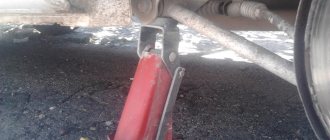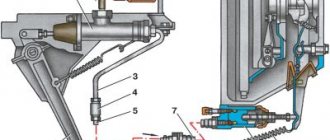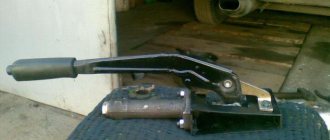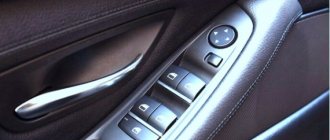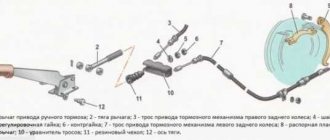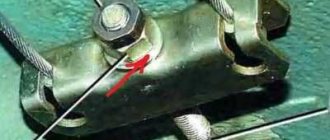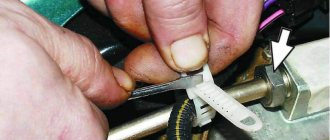Troubleshooting Methods
Oil leakage is the main problem, due to which the rolling jack does not lift completely (if the leak is small) or at all (if the leak is significant). Because of this, air enters the cavity, and then the hydraulic jack works with little force or refuses to work at all. Leaks in the hydraulic system can be prevented by routine maintenance and checking the oil level. If the level is low, you just need to add fluid to the normal level.
Due to lack of fluid, air leaks into the hydraulics. This problem is solved by bleeding: you need to unscrew the cap of the oil tank and the bypass valve, and then simply pump the system, that is, move the lever up and down until the liquid passes into the main cylinder.
Often the cause of hydraulic jack malfunction is corrosion on the pistons, rods and cavity of the unit. To determine the cause in detail and repair it, you will have to disassemble the device.
A bent rod is also a common reason why a rolling jack does not lift or operates jerkily. In this case, you can change this element by taking an analogue from the old model, or purchase a new part. In most cases, such a malfunction cannot be repaired at all, even in a workshop or service center. This is explained by the fact that the rod usually bends under shock loads, and in this case the main elements of the housing are damaged. In this option, it is cheaper to purchase a new unit without having to restore or replace individual parts.
When the bypass valve becomes deformed or dirt simply accumulates in it, the valve ball sits tightly in the seat and hydraulic fluid leaks through it. In this case, you will simply have to replace it and replace the old (contaminated) oil with new one.
Why won't the jack go down or up?
Reasons why the jack refuses to work:
- Cylinder failure. The working plane does not support the load; as a result, liquid flows from the cavity into the space above the piston.
- Damage to the mirror. Hydraulics lose efficiency or simply fail, this occurs due to improper transportation, it can lead to oil leakage and air entering the chamber, in which case corrosion will certainly begin over time.
- Corrosion. Leads to rapid wear of the cuffs and seals, which may result in dirt getting into the liquid and clogging the channels and valves.
- Unit fall. The greater the height from which the jack falls, the more serious the deformation of parts and main components can be.
- Too much load. Causes the rod to bend. This leads to misalignment of the main components and oil leakage.
- Use of the device for purposes other than its intended purpose, as well as failure to change the oil in a timely manner.
You might be interested in this About pneumatic jacks: how to make one from an air spring with your own hands
Rod curvature
Fault Detection
The rod extends to the desired height, but then slowly (without load) lowers - in this case, the reason is most likely in the bypass valve and damaged o-rings, so the required pressure is not maintained.
If the rolling jack does not lift to the end, it means that the working stroke has decreased. At this point, the culprit is the corrosion that has formed on the rod and the surface of the cylinder. If the load being lifted is greater than the lifting capacity of the jack (indicated in the passport and on the body in tons), then there is a possibility of damage to the rod and its bending.
In order for the jack to serve for a long time and not break, you must remember the following rules:
To fix a breakdown, you can lose a lot of time and money, so it’s easier to follow the operating instructions for a hydraulic jack, and then it will last a long time and will help lift the load more than once.
Source
Data protection
The company carries out effective multi-level work to protect clients’ personal data and the security of financial transactions in the system when working from a PC or mobile device. Provides services to protect clients from hacking and information theft:
- high-quality certified protection of web services and hosting (official certification has been passed for compliance with data security conditions);
- protection against DDoS attacks for clients of different levels of use: from corporate companies to individuals (IP addresses are protected around the clock by ARBOR equipment and other security systems);
- protection of financial transactions and personal data: encryption, confirmation by SMS code, and notification of changes via SMS alerts. To use this convenient service, registration is required, but it will not take much time and will save time later. If you have any questions or problems with registration, please contact your online consultant. Make your life more comfortable by making room for what’s important, entrusting your routine to reliable specialists and proven systems!
It is worth noting that if any problems or questions arise regarding interaction with your personal account, the company’s subscribers can contact the Hotline.
Quick repair of a hydraulic jack.
Sometimes problems arise with hydraulic jacks. Most people throw them away immediately. But don’t throw it away, maybe the problem isn’t that big.
If the jack begins to lower spontaneously when the car is lifted from the load, then it is most likely the seals and valves that are to blame. To replace them, you need to disassemble the jack. And it’s not so easy to find suitable ones. In this case, for me personally, it’s easier to buy a new one for a couple of thousand.
But it happens that the jack does not raise it to the required height. Previously, for example, the length of the rod was enough to lift the car, but now it is not. It rises halfway and that’s it. Oil is to blame here. More precisely, its lack.
When a working jack works, oil is still consumed. Quite a bit, but it is used up with each rise/fall. For good reason, it should be changed from time to time - about once a year. But who does this kind of nonsense here?) Usually it works as long as it works)
In general, two of my jacks malfunctioned. One is rolling, the other is bottle-type, both are hydraulic, of course. A rolling jack is the same as a bottle jack, only installed in a special design. After I raised the car, they slowly lowered it. I decided to add oil.
In general, it is recommended to add special hydraulic oils to such jacks. You can go and buy it, you can fill it with spindle oil, which is also hydraulic. Or you can, at your own peril and risk, top up with regular engine fuel. Which is what I did. This, of course, is not recommended, the properties of the oil are not the same, but oh well
.
First you need to lower the jack completely. We unscrew the fitting, lower the rod (or the lifting part of the rolling part), and screw the fitting back. We find the hole through which the oil is poured. It is closed with a rubber plug.
Carefully pry it up with a screwdriver and remove the plug.
Source
How to extend service life
- If you do not use the jack for a long time, it is recommended to periodically bleed the hydraulic system (at least once every 3 months). In this case, you will prevent the formation of corrosion and jamming of the piston.
- Remember to lubricate the rod with a light grease. This way you will significantly extend the life of the tool. It is also necessary to wipe the jack from dirt and dust, and inspect all parts (especially for oil leaks).
- If you do not plan to use a jack, the support part should remain completely lowered. Otherwise, over time it may begin to rust.
- Add hydraulic oil occasionally. Manufacturers do not recommend mixing oils of different brands.
- Once every 2 years, you need to completely flush the hydraulic system from dirt and small particles. It is also recommended to change the O-rings and cuffs.
- If you do not use the jack, you should store it in a dry place at above-zero temperatures.
How does a hydraulic jack work?
To accurately determine the cause of the breakdown and its subsequent elimination, you should have a clear understanding of the operating principle of the device. Fortunately, hydraulic jacks are quite simple, and most of their problems can be fixed on your own. Contacting service may be necessary in cases of serious defects or a complete lack of desire to read the repair instructions. The foundations for understanding the operation of the device should be laid by analyzing the main components of its mechanism.
Before describing the functional elements, it is worth noting that hydraulic jacks have several subtypes and are divided into rolling, bottle and diamond-shaped. The classic type of liquid lifting mechanism is most closely related to the bottle type, which includes devices with a telescopic, hollow, hook-on and standard rod. To form a correct basic idea, we will analyze the original model without additional modifications. So, a hydraulic bottle jack consists of the following components:
The main thing is that no air gets into the compartment, which can reduce stability and overall efficiency. It is for this reason that a hydraulic bottle jack does not work horizontally. However, even in this type of device there are models that allow lifting in different positions.
Tags
Hydraulic jack non-hydraulic jack hydraulic jacks anyhydraulic jack hydraulic jacks arrangedhydraulic jacks have lifting jack.transporting jack.hydraulic jack not working jack hydraulichydraulic rolling jackversions of bottle jack.bottle type jackhydraulic bottle useful Hydraulic hydraulic jackworking hydraulic jackbreaking hydraulic jacks does a hydraulic jack work what do hydraulic jacks do parts of a hydraulic jack bottle hydraulic jack why does a hydraulic trolley lifts hydraulic jack.
car handsoperation
Main malfunctions and their causes
Among all the reasons why a hydraulic rolling jack, bottle jack or diamond jack does not work, there are 3 main options: system clogging, valve failure or rod damage. It is on these 3 pillars that the most common breakdowns associated with a decrease in efficiency or complete failure of the system are based. For greater clarity, let's look at each case in more detail.
System clogged
may be caused by air, dust or dirt entering the liquid. As a result of the first option, the jack stop may not rise, spring strongly, or even fall completely under load. Accumulated lumps of dirt can limit the movement of the valves, which will no longer tightly close the channels, allowing fluid to pass in both directions. In this case, the stop will not be fixed in one position, gradually lowering to the zero point. When determining why a hydraulic jack does not hold, you should first pay attention to the cleanliness of the system.
Valve failure
, in addition to mud clogging, can be caused by mechanical damage. The ball at the end of the spring, resting in a cone-shaped groove, can become detached or get caught on other structural elements. In this case, the rod will not rise at all, since the circulation of liquid in the system is disrupted and pumping is not performed. This breakdown is more complex and requires disassembling the device. It is not recommended to consider it before checking the system for blockages.
Rod damage
may occur due to non-compliance with maintenance or storage conditions, as well as from working with large loads and violating operating rules. In the first case, the piston may become corroded, which will reduce the tightness of its seal to the cylinder, resulting in liquid leakage. If you lift loads that are heavier than the permissible limit, the stop may bend. The chances of such a breakdown increase with the maximum extension of the screw and uneven installation of the jack on the ground. Rod deformation is considered the most serious failure, which cannot always be repaired even in special centers.
Having covered the main causes of malfunctions, let’s move on to specifics. We will analyze the main problems and offer solutions.
Doesn't hold under load
The descent of the rod when resting on the load and even without strong pressure can be caused by two reasons: lack of oil or faulty valves. To find out for sure why a hydraulic rolling jack lowers, it is better to go from simple to complex. We will analyze each option separately, according to the degree of complexity of the repair procedure.
Doesn't lift well
One of the common troubles that arise in the operation of hydraulic jacks is the reduction in the speed of extension of the rod to a minimum or even to zero. This breakdown is often associated with a decrease in lifting height and a decrease in maximum load. The main reason for this malfunction lies in the airiness of the system, which occurred as a result of a drop in the oil level. In this case, restoring the efficiency of the device is not difficult. To do this, you will need a little oil (150-300 ml) and washing liquid (if the instrument is more than 2 years old).
Doesn't go down
A less common problem, but still relevant for many, is the stop sticking in the extended position. If the hydraulic jack rod has risen and does not fall, you can consider 2 options: a clogged shut-off valve or a deformed rod. The latter can be caused by mechanical damage (bending) from lifting loads exceeding the permissible weight. In this case, the only option is to replace the part if you are lucky enough to find one.
In addition to deformation, corrosion can form on the rod and internal walls of the cylinder due to long-term storage in improper conditions (with the rod extended, the valve unscrewed, in a humid environment). A tool with such a problem can be seen immediately by the abundant amount of rust. Restoration is possible by complete disassembly and rust removal.
If the hydraulic jack does not lower, but the rod rotates freely in a circle, then the problem lies in the shut-off valve. Most likely, while filling the oil, a small foreign object got into the jack. During pumping, it ended up in the cylinder, and when the rod was lowered, under pressure, it clogged the valve channel. The simplest, but not the most correct option is to unscrew the valve completely, expanding the channel as much as possible. If the operation is successful, some of the oil will flow out, but the rod will lower. If this does not help, the jack must be disassembled to get to the base of the cylinder and clear the blockage.
Source
What to do?
Doesn't hold under load
The lowering of the rod when it rests on the lifted load and sometimes without much pressure happens for 2 reasons: lack of oil or failure of the valves. Let's consider each option separately.
The lack of oil is due to normal leakage due to poor sealing; the jack bypasses oil. As a rule, this is the result of prolonged storage of the jack with the shut-off valve turned off or the wear of the gaskets. The issue can be resolved by adding oil and bleeding the device. It is advisable to use specialized oils for hydraulic systems; at worst, ordinary technical oils will do. If after filling the oil leaks even with the tap tightly closed, you need to buy a repair kit and change all the seals.
Valve failure may be due to contamination of the system or a mechanical defect. There is no need to disassemble the lifting device right away.
It would be wiser to first rinse the channels and internal surfaces that are dirty. For this purpose, drain all the oil from the device and add flushing liquid (gasoline or kerosene will do). It is pumped several times, the used liquid is drained, clean liquid is poured in, and so on 2 more times.
If washing has no effect, you will need to disassemble the jack and inspect the valves. They may not fit tightly due to loose springs or have deformed or worn out balls. The first reason is the most likely and can be corrected by rotating the spring or adding a small washer under it to increase the pressure by reducing the distance to the valve. A worn or deformed ball needs to be replaced.
Doesn't lift well
One of the most common problems is reducing the piston stroke speed to a minimum or idling too much. This malfunction is often associated with a reduction in lift height and a decrease in the maximum load. The main reason for such a problem lies in the airing of the system, which occurs as a result of a decrease in the oil level. Restoring the hydraulic jack to functionality in such a situation is quite simple. To do this, you will need 150-300 milligrams of oil and flushing liquid (if the device is older than 2 years).
What elements does the device of hydraulic jacks include?
Table of characteristics of jacks.
The lever of the device activates the pump, which pumps hydraulic fluid into the cylinder through a special valve. Hydraulic or working fluid is the oil that is squeezed out in the cylinder. The jack is lowered back down with the valve located on the pump open to allow hydraulic fluid to flow into it.
Using hydraulic jacks is easy. They must be located on level ground underneath the vehicle. After closing the valve of the device, its lever is pressed until the car is raised to the required height from the surface.
To lower the car back to the ground after the tire has been replaced, the valve opens smoothly counterclockwise. When the device is in its original position, the valve is closed back by turning it in the opposite direction.
How to bleed a jack correctly
Operating principle of a screw jack.
The jack, like any mechanism, requires periodic inspection and maintenance. Liquid can be added to the cylinder, since the use of the device is associated with oil leakage through the seals and oil seals. When using a jack to repair a car, use a safety stand. By adjusting the device with it, you can prevent the car from falling to the ground if the jack is faulty.
Storing the device in places where there is high humidity leads to rust on the cylinder. For the same reason, the working cylinder can become unusable. However, the disadvantage of a hydraulic jack is its slow operating speed and low lifting height. Some models have quite a large dead weight, so transporting it in the trunk is not very convenient.
Design and principle of operation
The design of hydraulic jacks is approximately similar to both rolling and bottle jacks. Main parts of rolling devices:
- piston;
- lever arm;
- stock;
- suction valve;
- stop valve;
- oil reservoir;
- working cavity.
It is necessary to lift the load by placing the unit on a level surface. When a person presses the handle, the rod generates pressure, as a result of which the valve is activated and oil enters the working cavity (chamber).
Dirt on the valve
When the handle is lifted up, the shut-off valve is activated, and oil enters the chamber due to the operation of the suction valve. By pumping oil from the reservoir into the cavity of the working cylinder, the piston is raised. Next, to lower the piston with the rod, the bypass valve opens, then under the pressure of the load the piston will lower.
That is, to lower the rod with the load, you must slowly unscrew the release valve located on the jack body.
How to fill the oil?
Hydraulic fluid is poured through the neck located on the side of the housing. It is also a level. There is no load on the plug, there is no pressure inside the body. Then the hydraulic jack needs to be pumped. This is a simple but responsible procedure.
After pouring, it is necessary to raise the rod to its maximum height (without load). Then the jack is placed horizontally, with the filler plug facing up. The plug is loosened and the rod is vigorously pressed into the cylinder. Most of the air will be squeezed out into the container with liquid.
Then the plug is tightly closed, and several (up to 20) full cycles of lifting to the maximum height with a load of 30-50 kg and lowering the rod are performed. After which you should perform a control lift under an increased (100-500 kg) load. If the jack does not “hold” the load, repeat pumping.
What oil should I fill? The one indicated in the product passport or in the instructions. If the documents are lost, find information on the manufacturer’s website. Experienced professionals advise using the so-called. spindle. This is only true for older models.
Still have questions? Watch a video about repairing a 12-ton hydraulic bottle jack.
Without a jack, a car enthusiast, without exaggeration, is left “without hands.” And it is needed not only to change a tire on the road. A good jack is indispensable for some types of repair work - especially in a regular garage that is not equipped with a lift. For example, when assembling the suspension after repair, when it is necessary to make the final tightening of the levers. There is absolutely no need to lower the car onto the wheels so that the silent blocks take the “working” position - just jack up the lever to give it the desired position. A rolling hydraulic jack is especially convenient - thanks to its design, it can be installed under a part located low - so that no other jack can get under it. But, like any other mechanism, the jack can fail. Repair of a rolling jack is available to anyone who repairs a car themselves.
We’ll just tell you what you need to pay attention to first when repairing a rolling jack with your own hands. First of all, let's look at its device
Modification of the rolling jack
Modifying the jack can be useful if you need to lift a load to a greater height, exceeding the factory specifications of the device. Also, modifications can quickly and easily solve the safety problem of the lifting mechanism. This can be solved by installing a clamp in the jacking platform. Both easy upgrade options are explained and shown below.
Increasing lift height
The low lift height may limit the jack's range of use for vehicles with high suspension. In such situations, tool owners may be interested in knowing how to increase the height of the rolling jack. A simple stop extension can be made from scrap materials. The guide below uses a brake cylinder from a Zhiguli, but you can use a regular thick-walled pipe of a suitable diameter.
First of all, you should prepare the adapter by welding a transverse plate to the top of the pipe in which you need to drill a hole for fixing (with the standard diameter).
Next, unscrew the bolt to which the thrust bowl of the rolling jack is attached. We remove the stop from its place and place an extension on it, with the drilled plate facing down. We place the previously removed bowl on top of the structure. We take a long bolt the diameter of the holes, thread it through the thrust bowl and pipe, and then tighten it with a nut.
Such jacks, with useful modifications in the form of increasing the lifting height, become useful for lifting SUVs and minibuses. At the same time, the added part (cylinder) remains a removable part of the mechanism, because it can be removed if necessary by unscrewing the bolt back.
Installing the retainer
So that when lifting the car you do not have to install an additional support to securely fix the car, a small modification of the rolling jack is required, which requires a minimum of time and materials.
We drill one 14 mm wide hole on both sides of the jack (approximately in the middle, opposite the central part of the rising piston mechanism of the jack).
We take a steel rod Ø 14 mm (we used a hinge rod for a rotary connection) with a pre-cut thread and a nut of the appropriate size for it. We raise the jack and fix the lifting part of the mechanism by inserting the kingpin into the holes made in the middle. Secure with a nut.
After these changes, the kingpin inserted into the jack will prevent the lifted car from lowering in the event of a sudden breakdown (failure) of the jack due to the opening of the exhaust valve. A more visual representation of this modernization is demonstrated in the following video.
Source
The main causes of hydraulic jack malfunctions and how to eliminate them
Jack repair diagram.
One of the most common causes of jack failure is oil leakage. As a result, air enters the working chamber, and as a result, the lifting mechanism does not work at full capacity or stops functioning.
This problem can be avoided by periodically performing maintenance on the hydraulic jack, which consists of monitoring the amount of fluid and, if necessary, adding it to the working cylinder. A decrease in the amount of oil in the system can be a consequence of natural operational loss, as well as due to damaged or faulty oil seals and seals. In this case, simply adding fluid will not solve the problem; it will be necessary to replace the failed seals and seals.
Due to the lack of working fluid in the system, air takes its place - this can be guessed by the reduced efficiency of the jack. You can get rid of this problem by pumping. To do this, open the oil tank cap and the bypass valve and bleed the hydraulic pump. If this is the fault, then if this work is performed correctly, the jack will be in working order again. But if this does not help, then either the cause of the malfunction is different, or more serious repairs will be required. Sometimes this problem can be solved by unscrewing the locking needle two turns, at the same time raising the piston to the top point, and then releasing it so that it reaches the bottom. This action must be repeated 2-4 times.
If corrosion or damage to parts is detected, they are replaced.
Often, the cause of incorrect operation of a hydraulic jack can be corrosion that affects the retractable pistons (rods or plungers) and the inside of the housing. But to find out the reason, you will need to disassemble the device. To do this, you can contact service workshops or do the work yourself. You will need a set of keys, a repair kit, a container for draining old oil and a canister with new oil to fill the system after repair.
A bent rod also often causes the jack to fail; in this case, if provided for by the design features of the model, it can be replaced with a new one, and often this means that the jack cannot be repaired even in a service workshop.
Dirt can be removed by washing it with kerosene. The bypass valve can also quite often be the culprit. It may have some deformation or dirt may have gotten into it, causing the ball to not sit tightly in the seat and therefore leaking fluid. This problem is solved mainly radically - by replacing the bypass valve.
Jack operating diagram
Diagram of operation of a hydraulic jack
Professional rolling jacks differ in size and load capacity. As a rule, the valve is controlled by turning the handle, which is very convenient during operation. But the principle of operation of all hydraulic jacks is the same, so it is more convenient to use the diagram - after all, despite the size and type of products, they have the same causes of breakdowns.
Rolling jacks differ in size and load capacity. Typically, the valve is controlled by turning the handle.
The force created by the plunger is transmitted through the oil used as the working fluid to the piston connected to the rod. In this case, oil is pumped from the front cavity of the jack cylinder to the rear cavity (from the plunger side). The bypass channel is closed, and the inlet and discharge valves allow the oil to move only towards the rear cavity, that is, the jack works like a pump. When the bypass needle (which is a pointed threaded rod) is opened, oil can flow back into the front cavity through the bypass channel. If at this moment the jack is under load, the piston rod will sink into the cylinder. The performance of the jack is ensured by compliance with three conditions:
- Tight fit of valves to seats.
- Required oil level.
- No air bubbles in the oil.
Instructions for proper bleeding of the jack device
Diagram for filling a hydraulic jack with oil.
Among the advantages of jacks, there is a rigid structure, as well as the height of lifting the load from the ground, the highest load capacity with smooth operation, and the minimum pick-up height. All these advantages result in high efficiency.
The reasons for equipment failure can be any. For example, prolonged use of the device can cause air to accumulate in the form of bubbles. This reduces the efficiency of using the jack, that is, its effectiveness drops sharply. This occurs due to air entering the hydraulic mechanism due to a lack of hydraulic fluid.
Bleeding and troubleshooting methods for the jack
The following actions will allow you to bring the device to its original state:
Otherwise, the above steps, according to the instructions, are repeated.
How to properly bleed a jack using a different algorithm
It is recommended to replace corroded parts.
Since the above method of bleeding the jack is not the only one, you can perform the following steps step by step:
The last operation is repeated 2-3 times. To prevent this problem from occurring, you should periodically check the fluid level in the jack. If it is not enough, then the oil must be added.
Bleeding the jack is repeated even after contaminants enter the working cavity. To remove contamination, the head of the housing is unscrewed, then kerosene is poured into its base. Next, the jack is pumped, having previously unloaded the shut-off needle. Having completed the operation, the kerosene is removed, and the working cavity is filled with clean hydraulic fluid.
In general, the algorithm looks like this:
This is done until all the air is released and the hydraulic oil is released in accordance with the bleeding of the brakes.
Recommendations
To increase the service life of the jack, it is advisable to follow the following rules.
- The lifting device oil must be changed twice a year. If the hydraulic jack is used every day, then it must be replaced at least once a month and must be washed.
- Any replacement oil can be used. But for the winter season, it is advisable to fill exclusively with synthetic types of oils.
- To prevent the lubricant from thickening in winter, the jack should be kept in a dry and warm room.
- When lifting work is carried out in winter, it must be remembered that if the device is used for a long time in severe frost, it can become unusable. In this regard, it is recommended to work with it in the most extreme cases and for a short time.
The ideal “repair” of a lifting device is preventative work to prevent breakdowns, in other words, continuous maintenance and timely replacement of the working fluid with pumping. Since eliminating any malfunction will require spending personal time, and sometimes some money. In this regard, it is necessary to follow all instructions for using hydraulic lifting devices, in which case they will work for quite a long time.
For repairs to a hydraulic jack, see below.
Main characteristics
Load capacity. Load capacity starts from 2t and above. For a simple passenger car for everyday needs, a carrying capacity of 2 tons is enough. This tool does not take up much space; it can be stored in the garage and taken with you on a trip. If you have an SUV, a load capacity of 3t or more is recommended. In any case, it is better to know the weight of the car in advance and be guided by its value in the choice.
Maximum lift height. It is different for each model
SUV owners need to pay maximum attention to this parameter. There is no point in paying for a tool that lifts the car 2 cm
The maximum lift height for SUVs starts from 450 mm.
Minimum height. The parameter determines the ability to roll the device under a car. A rolling jack with a minimum height greater than the ground clearance of your car will not help you. Be sure to measure the ground clearance before choosing.
Ease of use. Rubber pad, on the supporting support.
Type of mechanism drive. Cardan and gear. The recommended cardan type, it has proven its reliability and is also more repairable.
